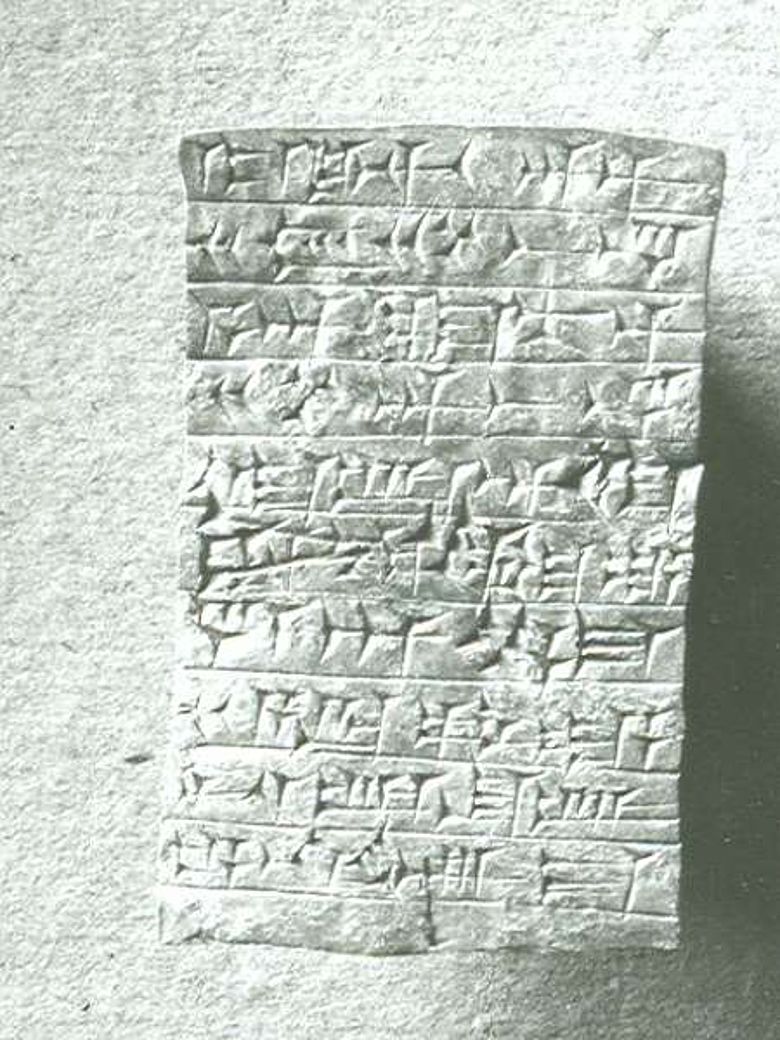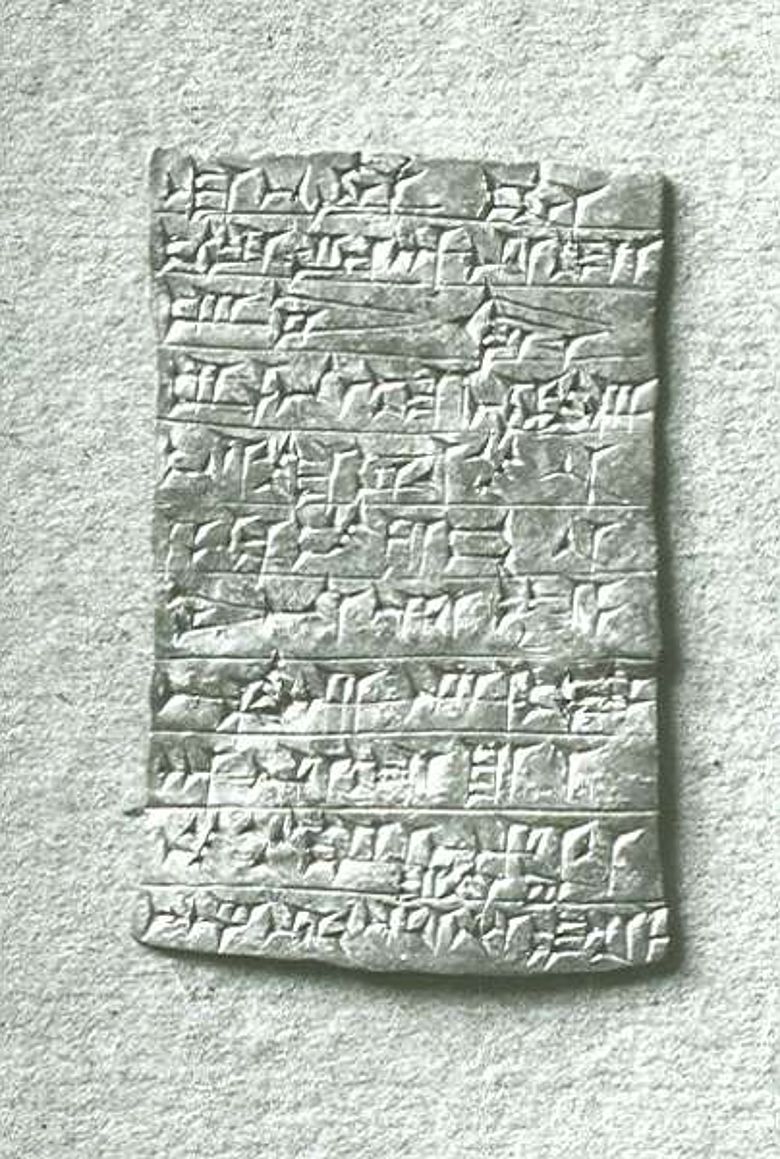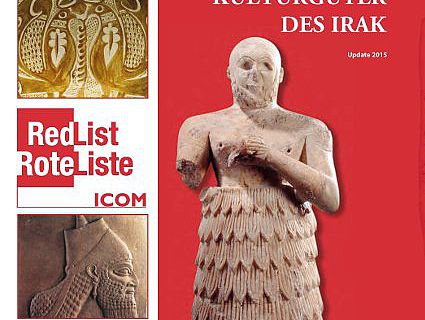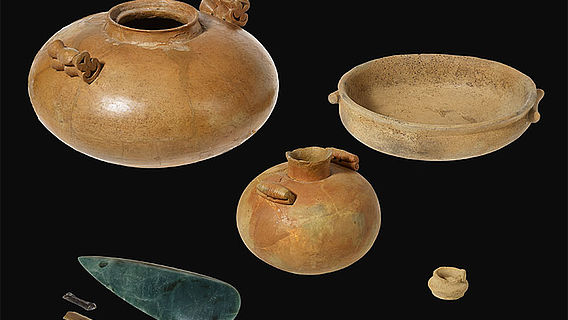Bei dem Täfelchen handelt es sich um eine Gründungsurkunde aus dem Ischtar-Tempel in Assur. Es wird in die Regierungszeit Königs Tukulti-Ninurta I. (1243-1207 v. Chr.) datiert. Das Täfelchen (Inventar-Nummer VA Ass 994) ist aus Gold, etwa 2,6 x 4 cm groß und hat ein Gewicht von 9,5 g. Die Übersetzung der Inschrift lautet:
Tukulti-Ninurta,
König der Gesamtheit, König von Assur,
Sohn des Salmanassar,
des Königs des Landes Assur:
Als der Tempel der (Göttin) Di-
nitu, meiner Herrin,
den Ilu-šuma,
ein König, der mit vorherging,
gebaut hatte – dieser Tempel
war verfallen und
alt geworden.
Seinen Schutt
schaffte ich fort (und)
grub bis zum Boden
seines Grundes.
Von seinem Fundament
bis zu seinen Zinnen erneuerte ich ihn (und)
meine Gedenkinschrift
legte ich nieder. Ein künftiger Fürst
möge ihren Verfall beseitigen (und)
meinen geschriebenen Namen (wieder) an seinen Platz legen.
(Dann) wird (Gott) Assur seine Gebete erhören.
Das Täfelchen wurde am 25. September 1913 entdeckt und gehört seit 1926 zum Bestand des Berliner Vorderasiatischen Museums. Ab 1945/46 galt es als verschollen. Vor einigen Jahren ist es im Nachlass von Riven Flamenbaum in den USA aufgetaucht. Der Familienüberlieferung nach hatte es dieser kurz nach Kriegsende auf dem Schwarzmarkt von einem russischen Soldaten erworben. Flamenbaum selbst war Überlebender des Holocaust. Ein Mitglied der Erbengemeinschaft, sein Sohn Israel, gab dem Berliner Museum den entscheidenden Hinweis auf den Verbleib des Täfelchens im Nachlass seines Vaters.
Hermann Parzinger sagt dazu: "Die Stiftung Preußischer Kulturbesitz hat den Auftrag, kriegsbedingt verlorene Sammlungsbestände zurückzugewinnen. Deshalb begrüßen wir die Entscheidung des Gerichts. Ich danke vor allem Israel Flamenbaum für seinen beispielhaft verantwortungsvollen Umgang mit dem Objekt, der uns sehr beeindruckt hat. Mein Dank gilt auch den 'amici curiae', die unseren Antrag an das Gericht mitgetragen haben. Besonders berührt hat mich auch die Unterstützung durch das Holocaust Art Restitution Project und die Israelitische Kultusgemeinde Wien."
Bei der Übergabe dankte Anwalt Raymond J. Dowd (Dunnington Bartholomew and Miller LLP) im Namen der Stiftung Preußischer Kulturbesitz allen Beteiligten und sagte:
My name is Raymond J. Dowd of Dunnington Bartholow and Miller LLP. With me in the courtroom today is attorney John Fisher of Hamburger Weinschenk and Fisher PC. On behalf of the Museum we would like to thank the court for the opportunity to express the Museum's gratitude for the safe and orderly return of this valuable Tablet and for a happy end to this long journey. As Dr. Ralf Wartke has certified, the Tablet is safe and intact and will be securely guarded on its journey to Berlin.
Our kindest thanks to all who are here in the courtroom. We hope that this ceremony will help to heal wounds of the Holocaust, wounds that run deep, and wounds that continue to hurt many families. The Museum expresses its sincerest sympathies for that suffering.
On April 20, 2006, attorney David T. Reilly, who is based in Mineola New York, wrote to the Museum on behalf of his client Israel Flamenbaum. Mr. Flamenbaum's attorney informed the Museum that provenance research suggested that the Tablet may have been part of the Museum's inventory. It was Mr. Reilly's letter, and Mr. Israel Flamenbaum's sharing of provenance research with the Museum, that enabled the Museum to locate, identify and retrieve the Tablet. The Museum thanks Mr. Flamenbaum for sharing this crucial information and for permitting the Museum to reclaim an important piece of the world's heritage. The museums of the world are thankful for the selfless efforts of those, like Mr. Flamenbaum, who assist public institutions in carrying out their mission.
The Museum also acknowledges the contribution of the late Fritz Weinschenk. Fritz, an American war hero who had been wounded at Omaha Beach, led the Museum's legal team through the appellate process in New York. Because he was Jewish, Fritz was driven from his German homeland by Nazi hatred and came to America and joined the war effort. After the war, he worked with the U.S. prosecution team trying war criminals at Nuremberg. Fritz died shortly after his successful argument before the Appellate Division, Second Department where he secured a decision awarding the return of the Tablet. More information on Fritz's extraordinary life may be found at a New York Times link provided in the written statement.
At the Court of Appeals level, the Museum wishes to thank the amici curiae (or 'friends of the court') who saw how important the return of the Tablet was to the Museum. These friends included prominent archeologists, museum professionals and scholars. But the friends of the court whom the Museum wishes to see especially acknowledged are the Holocaust Art Restitution Project and the IKG Wien (Jewish Community in Vienna). This important and credible support contributed in an important way to the perception of the Court of Appeals and to the public of the importance of the Tablet's return.
The Museum's mission, by law, is to 'ensure access to [...] cultural heritage in the public interest for the purposes of science, education and cultural exchanges between nations.' The Tablet will be returned to one of the world's great museums. Many may know the Pergamon Museum, which is located on Museum Island, in Berlin and houses the world-famous Ishtar Gate of Babylon. The Near East Asian Museum is found inside the Pergamon Museum. The public will soon be invited to view the Tablet in the context of the objects with which it was excavated.
The Tablet is unique. Its value to original scholarship is immeasurable. It is not a piece of jewelry. The Tablet is actually a 'public document' used in the Assyrian culture in the construction of temples. In this case, the Tablet contains an inscription from the Emperor Tukulti-Ninurta. It was found with other objects, such as seashells, that the Assyrians collected from the borders of their kingdom and that give us today important clues about the ideas that Assyrians had about God and cosmology. The use of different metals and materials tell us much about Assyrian concepts of cosmological diversity. The Museum has an exhibition on this topic to launch in 2018 and it hopes to welcome many New Yorkers in celebration and in study of this amazing culture.
Many items are still missing from the Museum. The Museum hopes that others will someday show the courage of Mr. Israel Flamenbaum and reach out to the Museum to help its staff in accomplishing its scholarly and cultural mission. We, and the scholars of the world, will welcome you with open arms.




